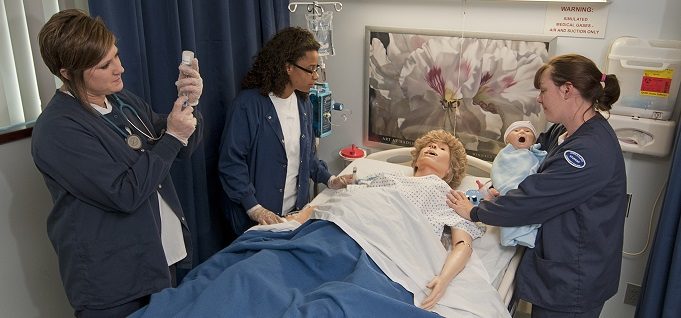Colleges help nursing students attain BSNs
By Ellie Ashford
January 11, 2017
Community colleges are providing nursing students with opportunities for academic progression.
As hospitals increasingly prefer nurses with bachelor’s degrees, community colleges are developing innovative ways to ensure nursing students have an opportunity to continue their education.
Some have agreements with universities for dual enrollment, for example, while others have formed partnerships allowing for a seamless transition to university-level programs with shared faculty and curriculums or plan to expand their programs to offer bachelor of science in nursing (BSN) degrees.
The drive toward encouraging more nurses to have BSNs comes from the 2011 Future of Nursing report by the Institute of Medicine, which set a goal of having 80 percent of nurses nationwide with BSNs by 2020.
Hospitals pursuing “magnet” status under the American Nurses Credentialing Center must have a plan to achieve that goal.
A 2016 survey by the American Association of Colleges of Nursing found that 54 percent of hospitals and other health settings require new hires to have a BSN, up 6.6 percentage points since 2015, while 98 percent of employers have a strong preference for BSN holders.
Academic progression
As a result, community college nursing program advocates have shifted their focus from maintaining the associate degree in nursing (ADN) as the only required credential for registered nurses to helping students pursue more advanced degrees.
Currently, just over half of U.S. nurses have a BSN and 57 percent of nurses began their nursing education at a community college.
“We want to be sure students, regardless of where they obtain an ADN, have an opportunity for academic progression,” says Christy Dryer, president of the Organization for Associate Degree Nursing (OADN), an affiliate of the American Association of Community Colleges.
“That doesn’t stop with the BSN. We want them to have opportunities for a master’s and doctorate degree, too,” says Dryer, who also serves as dean of nursing and health professions at Cecil College in Maryland.
In selecting a program, the most important factors for students tend to be cost and the length of time to a degree, says Cynthia Maskey, dean of health professions at Lincoln Land Community College in Illinois, and a member of the OADN board.
“That’s why it’s important that community colleges have good agreements, including discounts, with university partners,” Maskey says.
While it has generally been believed that ADN-prepared nurses do as well or better than BSN-prepared nurses on the National Council of State Boards of Nursing’s NCLEX licensing exam, the last time that happened was in 2005, notes Donna Meyer, chief executive officer of OADN.
The passing rates in 2016, through September, were 88 percent for nursing graduates with BSNs and 82 percent for those with ADNs.
Because ADN programs are shorter, it’s difficult to fit everything into the curriculum, Meyer says. Newer versions of the exam cover more material on research, management, leadership skills and the economics of healthcare, and those topics are not covered as extensively in two-year programs.
In OADN’s view, “the ADN is not the end all by any means,” Meyer says. “Our whole mission is about academic progression. The ADN is still a great entry point, but nurses need to have a chance to continue their education.”
The employment issue varies regionally, she says. In urban areas, it’s difficult to get a job without a BSN, while it’s not so much of a problem in other areas.
“In many communities, if it wasn’t for the community college, they wouldn’t have nurses in their community,” she notes.
There’s more to the story. Read the full article in Community College Daily.


